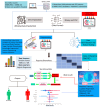Machine Learning-Augmented Triage for Sepsis: Real-Time ICU Mortality Prediction Using SHAP-Explained Meta-Ensemble Models
- PMID: 40564166
- PMCID: PMC12190226
- DOI: 10.3390/biomedicines13061449
Machine Learning-Augmented Triage for Sepsis: Real-Time ICU Mortality Prediction Using SHAP-Explained Meta-Ensemble Models
Abstract
Background/Objectives: Optimization algorithms are acknowledged to be critical in various fields and dynamical systems since they provide facilitation in identifying and retrieving the most possible solutions concerning complex problems besides improving efficiency, cutting down on costs, and boosting performance. Metaheuristic optimization algorithms, on the other hand, are inspired by natural phenomena, providing significant benefits related to the applicable solutions for complex optimization problems. Considering that complex optimization problems emerge across various disciplines, their successful applications are possible to be observed in tasks of classification and feature selection tasks, including diagnostic processes of certain health problems based on bio-inspiration. Sepsis continues to pose a significant threat to patient survival, particularly among individuals admitted to intensive care units from emergency departments. Traditional scoring systems, including qSOFA, SIRS, and NEWS, often fall short of delivering the precision necessary for timely and effective clinical decision-making. Methods: In this study, we introduce a novel, interpretable machine learning framework designed to predict in-hospital mortality in sepsis patients upon intensive care unit admission. Utilizing a retrospective dataset from a tertiary university hospital encompassing patient records from January 2019 to June 2024, we extracted comprehensive clinical and laboratory features. To address class imbalance and missing data, we employed the Synthetic Minority Oversampling Technique and systematic imputation methods, respectively. Our hybrid modeling approach integrates ensemble-based ML algorithms with deep learning architectures, optimized through the Red Piranha Optimization algorithm for feature selection and hyperparameter tuning. The proposed model was validated through internal cross-validation and external testing on the MIMIC-III dataset as well. Results: The proposed model demonstrates superior predictive performance over conventional scoring systems, achieving an area under the receiver operating characteristic curve of 0.96, a Brier score of 0.118, and a recall of 81. Conclusions: These results underscore the potential of AI-driven tools to enhance clinical decision-making processes in sepsis management, enabling early interventions and potentially reducing mortality rates.
Keywords: clinical critical decision support; deep learning; emergency department; in-hospital mortality; intensive care unit; machine learning; predictive modeling; sepsis; stacked ensemble model.
Conflict of interest statement
The authors declare no conflict of interest.
Figures








Similar articles
-
Supervised Machine Learning Models for Predicting Sepsis-Associated Liver Injury in Patients With Sepsis: Development and Validation Study Based on a Multicenter Cohort Study.J Med Internet Res. 2025 May 26;27:e66733. doi: 10.2196/66733. J Med Internet Res. 2025. PMID: 40418571 Free PMC article.
-
Signs and symptoms to determine if a patient presenting in primary care or hospital outpatient settings has COVID-19.Cochrane Database Syst Rev. 2022 May 20;5(5):CD013665. doi: 10.1002/14651858.CD013665.pub3. Cochrane Database Syst Rev. 2022. PMID: 35593186 Free PMC article.
-
Cost-effectiveness of using prognostic information to select women with breast cancer for adjuvant systemic therapy.Health Technol Assess. 2006 Sep;10(34):iii-iv, ix-xi, 1-204. doi: 10.3310/hta10340. Health Technol Assess. 2006. PMID: 16959170
-
Automated monitoring compared to standard care for the early detection of sepsis in critically ill patients.Cochrane Database Syst Rev. 2018 Jun 25;6(6):CD012404. doi: 10.1002/14651858.CD012404.pub2. Cochrane Database Syst Rev. 2018. PMID: 29938790 Free PMC article.
-
Factors that impact on the use of mechanical ventilation weaning protocols in critically ill adults and children: a qualitative evidence-synthesis.Cochrane Database Syst Rev. 2016 Oct 4;10(10):CD011812. doi: 10.1002/14651858.CD011812.pub2. Cochrane Database Syst Rev. 2016. PMID: 27699783 Free PMC article.
References
-
- Paudyal V., Cadogan C., Fialová D., Henman M.C., Hazen A., Okuyan B., Lutters M., Stewart D. Provision of clinical pharmacy services during the COVID-19 pandemic: Experiences of pharmacists from 16 European countries. Res. Soc. Adm. Pharm. 2021;17:1507–1517. doi: 10.1016/j.sapharm.2020.11.017. - DOI - PMC - PubMed
LinkOut - more resources
Full Text Sources

